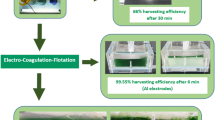Abstract
The following bead mills used for disruption of the microalga Chlorella cells were tested: (1) Dyno-Mill ECM-Pilot, grinding chamber volume 1.5 L; KDL-Pilot A, chamber volume 1.4 L; KD 20 S, chamber volume 18.3 L; KD 25 S, chamber volume 26 L of Willy A. Bachofen, Basel, Switzerland, (2) LabStar LS 1, chamber volume 0.6 L of Netzsch, Selb, Germany, (3) MS 18, chamber volume 1.1 L of FrymaKoruma, Neuenburg, Germany. Amount of disrupted cells decreased with increasing Chlorella suspension feed rate and increased up to about 85% of the beads volume in the grinding chamber of the homogenizers. It also increased with agitator speed and number of passes of the algae suspension through the chamber. The optimum beads diameter was 0.3–0.5 mm in the homogenizers Dyno-Mill and LabStar LS 1 and 0.5–0.7 mm in the homogenizer MS 18. While the degree of the cell disruption decreased with increasing cell density in Dyno-Mill and LabStar, the cell disruption in the MS 18 increased. Depending on processing parameters, more than 90% of algae cells were disrupted by passing through the bead mills and bacteria count in algae suspension was reduced to about two orders.





Similar content being viewed by others
References
Becker EW (1994) Microalgae—Biotechnology and microbiology. Cambridge University Press, 293 p
Doucha J, Lívanský K (1995) Novel outdoor thin-layer high density microalgal culture system: Productivity and operational parameters. Arch Hydrobiol 106/Algolog Stud 76:129–147
Doucha J, Lívanský K (1998, 1999): Process of outdoor thin-layer cultivation of microalgae and blue-green algae and bioreactor for performing the process. Greek Patent 1002924, 1998; US Patent 5981271 A, 1999
Doucha J (1998) The Chlorella program in the Czech Republic. Inst. Microbiol., Czech Acad. Sci., 16 p
Doucha J, Lívanský K (2006) Productivity, CO2/O2 exchange and hydraulics in outdoor open high density microalgal (Chlorella sp.) photobioreactors operated in Middle and Southern European climate. J Appl Phycol 18:811–826
Engler CR (1993) Cell breakage. In: Harrison RG (ed) Protein Purification Process Engineering. CRC Press, pp 37–55
Chisti Y, Moo-young M (1986) Disruption of microbial cells for intracellular products. Enzyme Microb Technol 8:194–204
Hatti-Kaul R, Mattiasson B (2003) Release of protein from biological host. In: Hatti-Kaul R, Mattiasson B (eds) Isolation and Puirification of Proteins. CRC, pp 1–28
Hedenskog G, Enebo L, Vendlová J, Prokeš B (1969) Investigation of some methods for increasing the digestibility in vitro of microalgae. Biotechnol Bioeng 11:37–51
Heim A, Solecki M (1999) Disintegration of microorganisms in a bead mill with a multi-disc impeller. Powder Technol 105:389–395
Kula MR, Schütte H (1983) Experiences with a 20 litre industrial bead mill for the disruption of microorganisms. Enzyme Microb Technol 5:143–148
Kula MR, Schütte H (1987) Purification of proteins and the disruption of microbial cells. Biotechnol Progr 3:31–42
Limon-Lason J, Hoare M, Orsborn CB, Doyle DJ, Dunnill P (1979) Reactor properties of a high-speed bead mill for microbial cell rupture. Biotechnol Bioeng 21:745–774
Mendes-Pinto MM, Rapovo MFJ, Bowen J, Zouny AJ, Morais R (2001) Evaluation of different cell disruption processes on encysted cells of Haematococcus pluvialis: effects on astaxanthin recovery and implications for bio-availability. J Appl Phycol 13:19–24
Middelberg APJ (1995) Process-Scale Disruption of Microorganisms. Biotechnol Adv 13:491–555
Mogren H, Lindblom M, Hedenskog G (1974) Mechanical disintegration of microorganisms in an industrial homogenizer. Biotechnol Bioeng 16:261–274
Molina Grima E, Belarbi EH, Acién Fernández FG, Robles Medina A, Vhosti Y (2003) Recovery of microalgal biomass and metabolites: process options and economics. Biotechnol Advances 20:491–515
Molina Grima E, Acién Fernández FG, Robles Medina A (2004) Downstream Processing of Cell-mass and Products. In: Richmond A (ed) Handbook of Microalgal Culture: Biotechnology and Applied Phycology. Blackwell, pp. 215–252
Mölls HH, Hörnle R (1972) Wirkungsmechanismus der Nasszerkleinerung in der Rührswerkkugelmühle. In: Rumpf H, Schönert K (eds) Dechema-Monographien No 1292–1362 (69), Teil 2. Verlag Chemie, Weinheim, p. 631–661
Novotný P (1964) A simple rotary disintegrator for micro-organisms and animal tissues. Nature. Apr 25; 202:364–366
Řeháček J, Beran K, Bičík V (1969) Disintegration of microorganisms and preparation of yeast cell walls in a new type of disintegrator. Appl Microbiol 17:462–466
Řeháček J (1971) Continuous disintegration of microorganisms in a new laboratory apparatus. Experientia 27:1103
Řeháček J, Schaefer J (1977) Disintegration of microorganisms in an industrial horizontal mill of novel design. Biotechnol Bioeng 19:1523–1534
Schütte H, Kula MR (1986) Einsatz von Rührwerkskugelmühlen und Hochdruckhomogenisatoren für den technischen Aufschluss von Mikroorganismen. Biotech-Forum 3:68–80
Schütte H, Kraume-Flügel R, Kula MR (1986) Scale-up of mechanical cell disintegration: Influence of the stirrer geometry on the residence time distribution in a 20 L high-speed bead mill. Ger Chem Eng 9:149–156
Schütte H, Kula MR (1990) Bead mill disruption. In: Asenjo JA (ed) Separation Processes in Biotechnology. Marcell Decker, pp. 107–141
Wimpenny JWT (1967) Breakage of microorganisms. Proc Biochem 2:41–44
Acknowledgements
We thank the institutions in which the experiments were performed: Willy A. Bachofen AG Maschinenfabrik, Basel, Switzerland; Netzsch Feinmahltechnik, Selb, Germany; ProTech laboratory, Neuenburg, of the FrymaKoruma, Rheinfelden, Germany.
We also thank the Czech representatives of these institutions for valuable cooperation.
Author information
Authors and Affiliations
Corresponding author
Rights and permissions
About this article
Cite this article
Doucha, J., Lívanský, K. Influence of processing parameters on disintegration of Chlorella cells in various types of homogenizers. Appl Microbiol Biotechnol 81, 431–440 (2008). https://doi.org/10.1007/s00253-008-1660-6
Received:
Revised:
Accepted:
Published:
Issue Date:
DOI: https://doi.org/10.1007/s00253-008-1660-6




